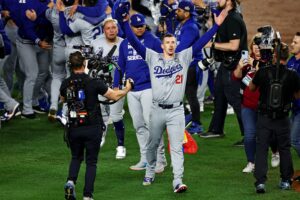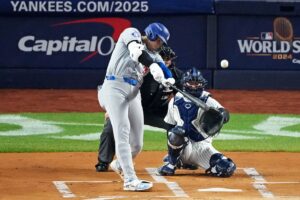The 2020 MLB Draft is in the books, and it will go down as one of the most unusual drafts in history. It was five rounds and the lack of pre-draft information led to an influx of college players taken early. The first high school player taken, Robert Hassell III, was not taken until the eighth pick, the latest ever in the MLB Draft.
As for the Washington Nationals, they had six picks. The Nationals had each of their original five picks and gained a second-round pick after losing Anthony Rendon. The Nationals stuck to their roots, taking a pitcher in the first round of the draft, and continued to rebuild a farm system that has been depleted in recent years.
Washington Nationals 2020 Draft Recap
Round One, Pick 22: Cade Cavalli
With their first pick in the draft, the Nationals continued a theme of power pitching, after taking Jackson Rutledge and Mason Denaburg in recent years, by selecting Cade Cavalli from the University of Oklahoma. Cavalli, standing 6’4 and weighing 226 pounds, has a big fastball that has touched 98, and has a plus power curveball alongside it. He also has had flashes of an excellent slider, with an average change-up. Delivery wise, he has very clean mechanics according to many scouts.
Although Cavalli offers excellent upside, there are concerns over his health and command. He had a lower back injury his senior year in high school, and a stress reaction in his arm in college. In his first three years at Oklahoma, Cavalli had 5.2 BB/9. Despite that, the Nationals hope that Cavalli can continue to improve his command, as he did his senior year, and reach his full potential. With an aging rotation and a weak farm system, the Nationals need Cavalli to develop into a solid big-league pitcher.
Round Two, Pick 55: Cole Henry
The Nationals doubled down on pitching and selected another pitcher with high upside and high risk. Cole Henry had a 1.89 ERA in four starts in the abbreviated 2020 season. With a mid-90s fastball, Henry has good sinking action and command, which give him the potential to be a groundball pitcher, with the ability to pitch for a strikeout. In addition to his fastball, Henry has shown flashes of a plus curveball with excellent spin. Henry’s changeup has shown improvement in command and movement, but must continue to develop for him to be a consistent starter.
Being just 20-years old, Henry has a chance to add strength and velocity to his fastball, which could give him a mid-90s fastball, with a plus curveball. Add that to a developing changeup, and Henry could become a number three starter in the big leagues. At the very least, Henry will add solid depth to the Nationals farm system.
Round 2, Pick 71: Samuel Infante
The Nationals picked their first position player, and high schooler of the 2020 MLB draft by selecting Samuel Infante from Monsignor Edward Pace HS. The 18-year old shortstop hit .481 in the shortened 2020 season with four doubles and one home run. The Nationals VP of Scouting Ops, Kris Kline, had this to say about Infante: “Twitchy, he’s got a high motor, high-energy guy. Loves to play, you can tell, he’s always smiling. So much energy on the field, it was fun watching him. He has a good chance to stay at shortstop. He can throw.”
With this selection, the Nationals added to their infield strength in their farm system as Infante joins Carter Kieboom, Luis Garcia, and Yasel Antuna. With their compensation pick, the Nationals hope they can develop Infante into a shortstop as Trea Turner becomes a free agent in 2022.
Round 3, Pick 94: Holden Powell
The Nationals went to the bullpen in the third round by taking Holden Powell from UCLA. Powell has a two-pitch mix with a mid 90s fastball, and a wipeout slider as his out pitch. This season, Powell had 9.1 scoreless innings with a whopping 20 strikeouts. Powell was excellent last year and he had 65 strikeouts in just 49 innings. Despite his plus stuff, Powell needs to continue to improve his command as he walked 27 in the 2019 season.
Hey @Nationals fans, if you like pitchers who can get swings-and-misses like this, Holden Powell (@getHolden) is going to fit right in. #GoBruins | #MLBDraft pic.twitter.com/wopLwkXi1O
— UCLA Baseball (@UCLABaseball) June 12, 2020
Although Powell has a developing changeup, it is unlikely that the Nationals would try to convert him to a starter. With a solid two-pitch mix, Powell could rise up the Nationals farm system quickly and become a mid-to-late inning reliever if he continues to improve upon his command.
Round Four, Pick 123: Brady Lindsly
In the fourth round, the Nationals added to one of the weakest parts of their farm system by taking Brady Lindsly, a catcher from Oklahoma. Lindsly, Cavalli’s teammate, hit .271 in 14 games in the 2020 season, while hitting three home runs. He was under the radar the entire draft process and unranked by MLB.com and Baseball America. Even he was surprised when he was selected. Lindsly said, “I was just shocked, honestly. I thought I was looking at the free agent thing the whole way, and when I got the call I was just speechless.” Lindsly projects as an average defensive catcher, who has shown potential of being an above-average hitter after he posted a .364 OBP in his junior season at Oklahoma.
Currently, the Nationals best catching prospect is Israel Pineda. With an aging catching tandem at the MLB level, the Nationals need one of their young catchers to develop into a passable starter, or a defensive-minded backup. Lindsly should be a solid catcher at the next level on the defensive side, but must continue to add power to become an average offensive player to stick at the MLB level.
Round Five, Pick 153: Mitchell Parker
The Nationals went back to San Jacinto after selecting Jackson Rutledge in the first round last season by picking Mitchell Parker, a left-handed starting pitcher. Parker has a unique pitching motion as his low-90s fastball comes from the overhand slot. He also has a solid curveball along with it. Kris Kline said that “he commands the curveball better than the fastball, you know, a little fine-tuning with the delivery.”
In the 2020 season, Parker went 5-0 with a 1.19 ERA and 64 strikeouts. However, Parker did have 18 walks in just over 30 innings pitched. Parker seems like a project for the Nationals, as needs some tweaks to his delivery, and he needs a third pitch to remain a starter.
Jesse Dougherty, from the Washington Post, reported that Mitchell Parker has signed with the Nationals. The bonus is not known as of now.
Fifth-round pick Mitchell Parker, a lefty out of San Jacinto, has signed with the Nationals. Not sure on his bonus quite yet. Slot value for the pick (153) is $346,800.
— Jesse Dougherty (@dougherty_jesse) June 12, 2020
Final Review and Moving Forward
With Max Scherzer heading into the second to last year of his contract and an aging rotation, the Nationals desperately need youth in their farm system to eventually be ready to replace their “big four” starting pitchers. The Nationals stuck to their roots, by taking pitchers with four out their six picks. By taking Cavalli, Infante, and Henry with their first three picks, the Nationals went with upside in the draft, following a theme of Mike Rizzo in recent drafts.
Since Anthony Rendon was drafted in 2011, the Nationals draftee with the highest WAR on the team Erick Fedde who has been very inconsistent at the MLB level. This goes to show the depleted farm system of the Nationals due to various trades, such as the Adam Eaton trade, and the Sean Doolittle trade. The Nationals hope to hit on their first three picks in the draft, to reload a farm system that needs help for an aging team.
Main Photo: Embed from Getty Images






